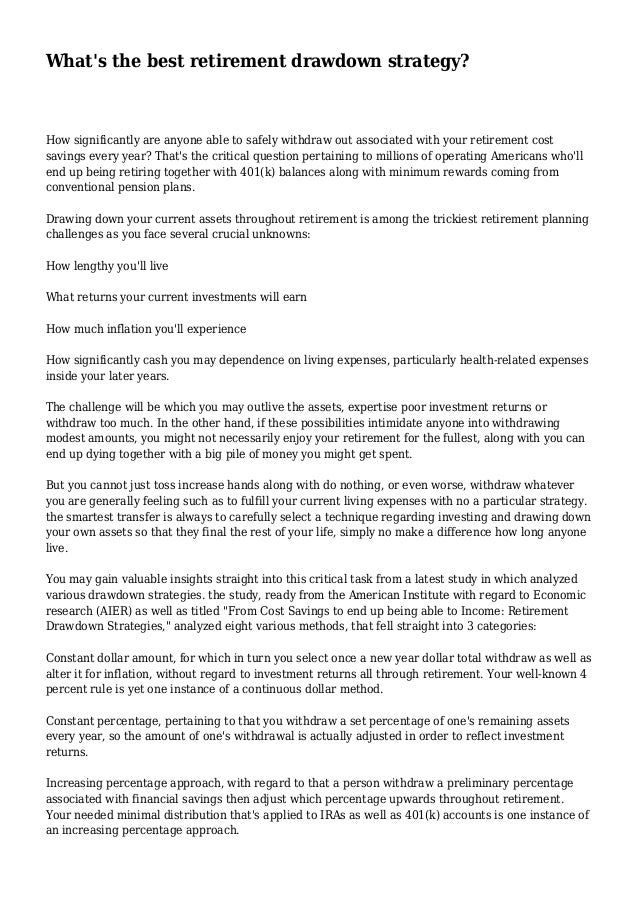

This may influence which products we review and write about (and where those products appear on the site), but it in no way affects our recommendations or advice, which are grounded in thousands of hours of research. So how do we make money? Our partners compensate us.

And while our site doesn’t feature every company or financial product available on the market, we’re proud that the guidance we offer, the information we provide and the tools we create are objective, independent, straightforward - and free. We believe everyone should be able to make financial decisions with confidence. Our estimates are based on past market performance, and past performance is not a guarantee of future performance. At ages 72 and older in contrast, after required distributions begin, 41 percent of households withdraw more than 5 percent of their PRA balance in a typical. Examples are hypothetical, and we encourage you to seek personalized advice from qualified professionals regarding specific investment issues. NerdWallet does not and cannot guarantee the accuracy or applicability of any information in regard to your individual circumstances. They are not intended to provide investment advice. Its articles, interactive tools and other content are provided to you for free, as self-help tools and for informational purposes only. is an independent publisher and comparison service, not an investment advisor. However, it can quickly become time-consuming, and you still need to use another method to determine how much you can afford to spend each year.NerdWallet, Inc. The major benefit of this approach is that you have more control over when you sell investments and can potentially grow your investment account balance over time. If both stocks and bonds are down, you continue to draw from your savings. When you refill your savings account, you do so either by selling stocks if the market is up or selling your fixed income securities if they’ve performed well. However, this pattern may not hold as the Baby Boomer. This enables you to avoid selling assets at a loss. Past generations drew down their wealth slowly in retirement, leaving much of their savings untouched. With this approach you draw from your savings account to cover your expenses and refill that “bucket” with money from the other two. Fixed-income securities, including government and corporate bonds or certificates of deposit.A savings account that holds approximately three to five years’ worth of living expenses in cash.When you implement a buckets strategy, you have three separate sources of retirement income: And if your investment gains don’t keep pace with inflation, you could see your buying power fall. This again makes it difficult to create a financial plan. Your income will also vary from year to year, depending on market performance. Unfortunately, your nest egg needs to be quite large to provide enough income for you to live on. The major benefit of this approach is that you cannot run out of money in your retirement account.

You withdraw only the income your investments produce from interest or dividends. Systematic withdrawals leave your principal invested throughout the entirety of your retirement. If you followed this withdrawal schedule and your investment account earned an average 3% annual return throughout your retirement, your balance at the end of 20 years would be approximately $243,518. The chart below shows the income that would be available to you over a 20-year retirement if you were to retire with $500,000 in 2020 and follow the 4% rule (assuming a 2% inflation rate). This rule also doesn’t provide flexibility to adjust based on the performance of your investments. However, with rising interest rates and increased market volatility, there’s a risk you could run out of money using this approach. The major benefit of the 4% rule is that it’s a simple approach and you're buying power keeps pace with inflation. If there’s 2% inflation (which is the Federal Reserve’s target rate of inflation), you would withdraw $20,400 the following year. If you follow the 4% rule and begin retirement with a nest egg of $500,000, you would withdraw $20,000 during your first year of retirement. Each year, you’ll increase the amount to keep pace with inflation, the rising cost of goods and services. If you follow the 4% rule, you’ll withdraw 4% of your investment account balance in your first year of retirement.


 0 kommentar(er)
0 kommentar(er)
